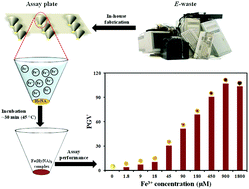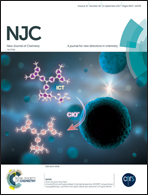A versatile optical assay plate fabricated from e-waste and its application towards rapid determination of Fe3+ ions in water†
Abstract
A novel approach for reusing e-waste towards the design of low-cost analytical tools/devices has been presented. An optical assay plate with cone-shaped wells was fabricated, which can serve as a versatile tool for rapid assays. In the present study, we have demonstrated the application of the assay plate towards the sensitive detection and precise determination of Fe3+ ions using highly selective 2-hydroxy-1-naphthaldehyde (HyNA) reagent. The proposed method was optimized against common analytical parameters, e.g. base diameter, analyte volume, solution temperature and pH. At the optimal experimental conditions, the repeatability of the signal intensity values in various wells was confirmed with an acceptable standard deviation (based on 3 s), relative standard deviation (5.1) and RSD (±7.1%). A good limit of detection (based on 3 s/b = 1.8 μM) and limit of quantification (based on 10 s/b = 5.4) of total Fe3+ ions and linear dynamic range (18–900 μM) were successfully achieved. In the absence of the fabricated plate, the assay performance showed 50% reduction in the signal density and a higher limit of detection (i.e., 90 μM). Due to its high selectivity and negligible interference, the proposed method was successfully applied for the detection and precise determination of Fe3+ ions in tap and marine water samples.



 Please wait while we load your content...
Please wait while we load your content...